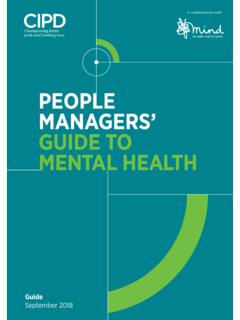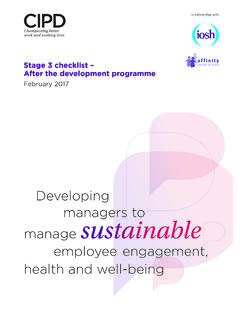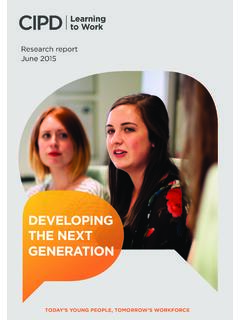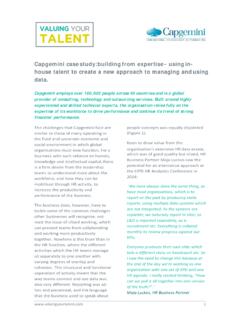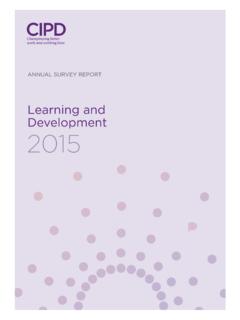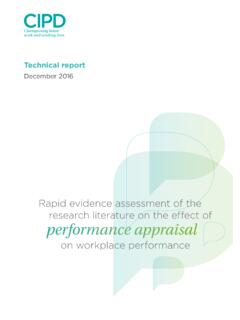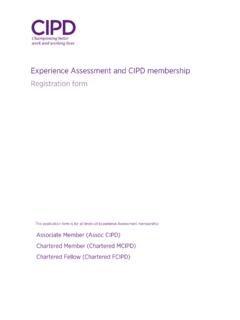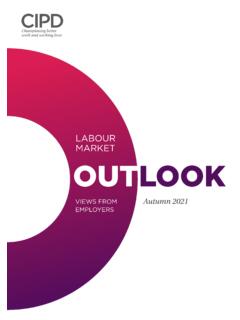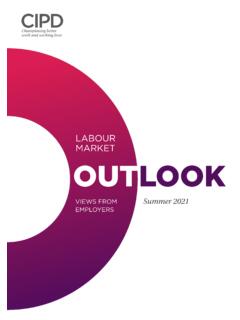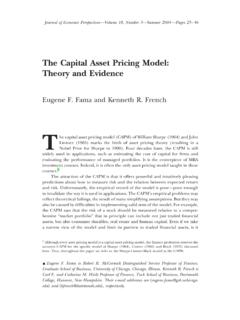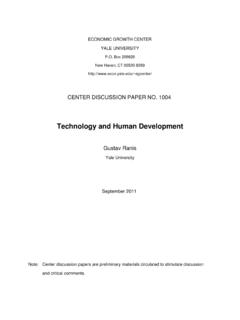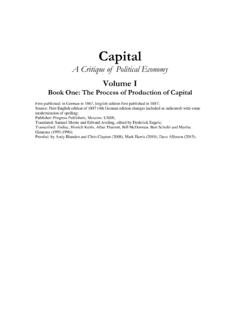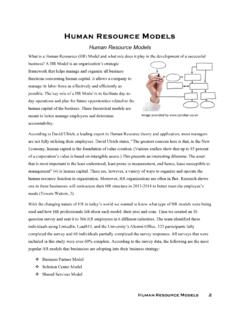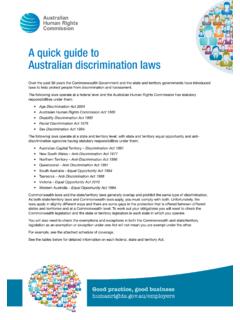Transcription of Human capital theory - CIPD
1 Technical report May 2017 Human capital theory : assessing the evidence for the value and importance of people to organisational successin partnership withThe CIPD is the professional body for HR and people development. The not-for-profit organisation champions better work and working lives and has been setting the benchmark for excellence in people and organisation development for more than 100 years. It has more than 140,000 members across the world, provides thought leadership through independent research on the world of work, and offers professional training and accreditation for those working in HR and learning and | What s material in Human capital reporting? 1 Human capital theory : assessing the evidence for the value and importance of people to organisational success Technical report Contents Foreword.
2 2 Executive summary .. 3 Introduction .. 5 1 Human capital at the individual level ..12 2 Human capital at the organisational level ..30 3 Measuring Human capital : the theoretical perspective ..49 Conclusions and recommendations ..58 Appendix 1: Research methodology ..62 References ..67 Acknowledgements We would like to thank the team who developed and conducted this research at the Ulster University Business School. This report was written by Dr Martin McCracken, Professor Ronan McIvor, Dr Raymond Treacy and Mr Tony Wall. 2 Foreword As the CIPD works to evolve the HR profession, there are important questions that must be answered as to the value and nature of the relationship between people and work. Scholarship in accountancy, and more recently in the HR and management domains, has conceptualised value as the knowledge, skills and abilities, or Human capital , of the workforce.
3 These characteristics and attributes, in their purest form, are the crucial inputs from which value is generated by organisations. Human capital is therefore a fundamental concept for the HR profession to understand if organisations of the future are to deliver long-term success. This technical report examines the academic perspective on Human capital , its definition and the fundamental concepts that underpin its conceptual value. By reviewing published academic literature, this reports acts as an evidence base for the HR profession, by defining a clear line in the sand from which future research and investment in capability can grow. Complementing this report is an additional assessment of the measurement of people and Human capital , commonly described as HR analytics, which considers the academic perspective on the process of measurement and reporting people data (Charlwood et al 2017).
4 In combination, these technical assessments form part of the evidence for the evolving HR body of knowledge, the implications and synthesis of which forms part of the CIPD discussion report Human capital analytics and reporting: exploring theory and evidence (Houghton 2017). Building the evidence base for the value and contribution of people to business success is central to enhancing the capability of HR professionals to build the conditions to create more effective decision-making. Evidence such as this, written from the perspective of leading academic thinkers, is one vital source of insight that can help to improve the capability of the profession. This report offers a thorough and clear assessment of the academic debate as to the nature of the value of people in organisations, and as such should be seen as an important contribution to the HR and people management body of knowledge.
5 Edward Houghton Research Adviser, Human capital Metrics and Standards, CIPD 3 Executive summary Oscar Wilde once said, A cynic knows the cost of everything, but the value of nothing. Indeed, the same can be said for organisations that view their workforce as a cost, rather than an asset to be nurtured and developed over time. Many modern-day organisations have now come to the realisation that it is the firm s intangible assets, such as the knowledge and skill of their employees, that is fundamental to creating value and attaining a sustainable competitive advantage over rival firms. Organisations today find themselves operating in a knowledge economy, and this raises many questions as to how firms can facilitate the creation, development and sharing of knowledge amongst its employees. Hence, the management and measurement of Human capital (HC) has become an issue of great strategic importance.
6 Purpose: key questions The purpose of this report is to consider how scholarship and academically published literature considers Human capital in organisations, and to consider the relationship between Human capital and concepts through Human resources management, accounting and strategic management literature. Two key questions informed the development of this research, namely: 1 What is Human capital , social capital and intellectual capital , and how are they considered in published academic literature? 2 How do the accounting and Human resources management domains consider the measurement of Human capital ? And how are these perspectives considered in published academic literature? This report critically reviews the literature surrounding HC management with the aim of examining the contemporary academic perspectives on measuring Human capital .
7 It does this by drawing insight from a variety of academic perspectives. This involved reviewing the academic literature at both the individual and organisational level and underlining the factors that help create an environment where HC can thrive. At the individual level, this involved examining the antecedents which influence individual performance, such as motivational psychology and employee engagement, employee behaviour, talent management and career development. At the organisational level, issues such as capability development, firm governance, corporate leadership and organisational behaviour were considered. Moreover, in contrast to previous literature reviews on HC, this report takes a multi-level perspective and examines how both employee- and corporate-level capabilities intertwine to improve firm performance.
8 Summary of findings The review also underlines the vital role social capital plays at both the individual and organisational level in terms of creating value and stimulating new knowledge and innovation. For instance, it has been highlighted that social capital is the catalyst that converts the knowledge of individuals into the knowledge of the organisation, and vice versa. The report also highlights the notion that in order to cultivate and develop HC, an organisation must be able to identify and measure how more recent initiatives impact upon 4 the development of HC within organisations. The report also underlines the observation that the measurement and reporting of HC becomes a fundamental knowledge source in itself for not only facilitating the development of HC within organisations but also predicting and sustaining HC performance in the longer term.
9 Finally, the report emphasises the importance of linking contemporary operating strategies to the design and generation of HC metrics in order to improve organisational outcomes. The concluding sections of this report also discuss areas for future research in terms of measuring the interaction between Human , social and structural capital , exploring the role of organisational teams and employee well-being in the relationship between HC development and firm performance and, finally, identifying how HC can be leveraged to facilitate organisational change. 5 Introduction The rise of intangible resources and intellectual capital The twenty-first century has witnessed the transition from the production economy to the knowledge economy, and there has been a paradigm shift in the way assets are viewed within organisations.
10 Traditionally, the long-held belief was that a firm s physical assets paved the way for economic success; however, as Becker describes, physical resources explain only a relatively small part of the growth of income in most countries (Becker 1964, p1). From a strategic management perspective, physical resources confer little advantage to organisations because they can be bought and sold on the open market with ease (Rothaermel 2012). In a knowledge economy, it is the intangible abilities and skills of the workforce and the knowledge inherent within the organisation s structures, routines, systems and processes which can contribute towards the knowledge capital of the organisation (Grant 1996a, Mahoney and Kor 2015). This knowledge capital is commonly referred to as a firm s intellectual capital (IC).
